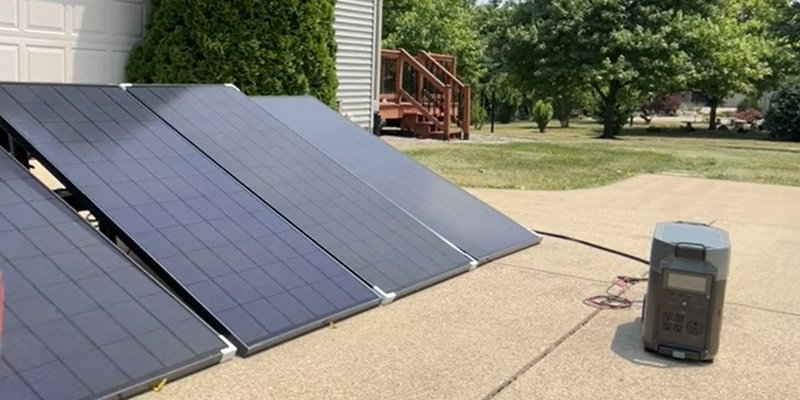Disclosure: This post contains affiliate links and I will be compensated if you make a purchase after clicking through my links. Learn More
A solar generator typically charges in 2 to 8 hours. Charging time depends on several factors.
These include the size of the solar panels, the amount of sunlight, and the generator’s battery capacity. Understanding these elements helps in planning the use of solar power efficiently. Solar generators are becoming more popular as people look for clean energy solutions.
They provide a reliable source of power during outages or off-grid adventures. Knowing how long it takes to charge can help users maximize their solar generator’s potential. This knowledge ensures you are prepared for any situation. Whether camping or dealing with power outages, understanding charging times is essential. Let’s explore what influences these times and how you can optimize your solar charging experience.

Solar Generator Basics
Understanding solar generators is vital for harnessing clean energy. These devices convert sunlight into electricity. They store power for later use. They offer a sustainable way to power homes and devices.
Solar generators are gaining popularity among eco-conscious consumers. They reduce carbon footprints. They provide reliable energy. This makes them a practical choice for many households.
Components Of A Solar Generator
Solar generators have three main parts. Solar panels capture sunlight. They convert it into electrical energy. The battery stores this energy for use when needed.
The charge controller manages the energy flow. It prevents battery damage. It ensures efficient energy storage. Together, these components make solar power accessible.
How Solar Generators Work
Solar panels absorb sunlight. They transform it into electricity. This electricity charges the battery. The stored energy powers devices later.
The charge controller protects the battery. It regulates the energy flow. It helps maintain battery health. This system provides a steady power supply.
Solar generators are easy to use. They require minimal maintenance. They offer a green solution for energy needs.
Factors Influencing Charging Time
Understanding how long a solar generator takes to charge is crucial. Several factors influence this time. Recognizing these can help in making informed decisions. Let’s delve into the specifics.
Solar Panel Efficiency
Solar panel efficiency is a key factor in charging time. Efficient panels convert more sunlight into electricity. This reduces the time needed for charging. Panels with high efficiency work better even in low light. This ensures a steady power supply. Check the efficiency rating before purchasing solar panels.
Battery Capacity
Battery capacity plays a significant role in how quickly a generator charges. Larger batteries store more energy. They take longer to charge fully. Smaller batteries charge faster but hold less power. Choose a capacity that fits your energy needs. Balance between charging time and energy storage is important.
Types Of Solar Generators
Solar generators come in various types, each serving different needs. Understanding these types helps determine how long charging takes. Two main types are portable and home solar generators.
Portable Solar Generators
Portable solar generators are compact and easy to carry. Ideal for camping trips or emergency power needs. They usually have smaller solar panels. Charging time depends on panel size and sunlight availability. On average, it takes 5 to 8 hours to charge. Perfect for outdoor adventures.
Home Solar Generators
Home solar generators are larger and more powerful. Designed to provide energy for household appliances. They require larger solar panels. Charging can take 8 to 12 hours, depending on weather conditions. Suitable for homes in sunny areas.
Charging Methods
Charging methods play a vital role in the efficiency of solar generators. Understanding these methods helps you plan your energy needs better. Two common ways to charge a solar generator are solar panel charging and wall outlet charging. Each method has its unique benefits and time requirements. Let’s delve into these charging methods to understand their processes.
Solar Panel Charging
Solar panel charging uses the sun’s energy to power your generator. This method is eco-friendly and cost-effective. The time it takes depends on sunlight exposure and panel size. Bright, sunny days charge the generator faster. Cloudy or rainy days may extend the charging time. Panel efficiency also affects how quickly energy is stored. Larger panels generally provide more power. Solar panel charging is ideal for outdoor use.
Wall Outlet Charging
Wall outlet charging offers convenience and speed. Plug your generator into a standard outlet to charge. This method is faster than solar panels. It is unaffected by weather conditions. Charging times vary based on the generator’s battery capacity. Small generators charge quickly. Larger ones may take several hours. Wall outlet charging suits indoor environments. It’s perfect for quick energy boosts when sunlight is limited.
Estimating Charging Time
Charging time for a solar generator depends on factors like battery size and solar panel wattage. Typically, it takes 8 to 12 hours under ideal conditions. Cloud cover or low sunlight can extend this duration.
Estimating how long it takes to charge a solar generator can be a bit tricky but entirely manageable. Imagine setting up your solar panels on a sunny day, eager to power up your devices. Knowing the charging time helps you plan your energy usage efficiently. This section will break down the factors that influence charging time and provide you with a simple approach to estimating it.
Calculating Based On Solar Output
To estimate charging time, you first need to know the solar output of your panels. Solar panels are rated in watts, and this tells you how much power they can produce under optimal conditions. For example, a 100-watt solar panel can generate 100 watts of power in an hour of full sun.
Consider the capacity of your solar generator, which is measured in watt-hours (Wh). Divide the generator’s capacity by the panel’s wattage to get a rough estimate of charging hours. If your generator is 500Wh and you have a 100-watt panel, you’d need approximately five hours of full sun to charge it fully.
Impact Of Weather Conditions
Weather conditions play a significant role in charging time. On a clear, sunny day, your panels will perform at their best, possibly even exceeding expectations. However, on cloudy or rainy days, solar output can drop significantly, sometimes to just 10-25% of their rated capacity.
Read More: Do Solar Panels Work on Cloudy Days?
Think about those overcast days when you might have planned an outdoor event, only to have rain ruin it. Similarly, solar panels require direct sunlight for maximum efficiency. It’s wise to have a backup plan, like additional panels or a generator, to ensure you have the power you need even on less-than-perfect days.
Have you ever wondered how much you rely on weather forecasts? In the world of solar charging, checking the weather isn’t just about planning a picnic—it’s about ensuring you have enough power to keep your gadgets running. Planning with weather in mind can save you time and frustration in the long run.
Optimizing Charging Speed
Optimizing the charging speed of your solar generator requires strategic planning. Efficient charging ensures your solar generator is ready when needed. This involves selecting appropriate solar panels and optimal positioning to capture sunlight.
Choosing The Right Solar Panels
Select solar panels that match your generator’s capacity. Larger panels capture more sunlight. This speeds up charging. Check the panel’s wattage and compatibility with your generator. High-efficiency panels convert sunlight into energy more effectively. This reduces charging time. Consider portable solar panels for flexibility. They allow easy movement to sunny spots.
Positioning For Maximum Sun Exposure
Place your solar panels in direct sunlight. Avoid shaded areas. Shading reduces energy absorption. Tilt the panels toward the sun. Adjust the angle as the sun moves. This maintains optimal exposure. Clean the panels regularly. Dust and dirt block sunlight. Ensure the panels face south in the northern hemisphere. This captures sunlight throughout the day.
To know the accurate angle use this solar panel tilt angle calculator.
Common Myths
When it comes to solar generators, many misconceptions float around, especially about how quickly they can charge. These myths can often lead to unrealistic expectations and disappointment. Let’s debunk some of the most common myths surrounding solar generator charging times.
Myth Of Instant Charging
There’s a widespread belief that solar generators can charge instantly as soon as they’re exposed to sunlight. This isn’t true. While it’s tempting to think that a bright sunny day will have your generator fully charged in no time, the reality is different.
Solar generators rely on the amount of sunlight and the efficiency of their solar panels. Even on the sunniest days, charging isn’t instantaneous. I once waited all afternoon for my solar generator to charge while camping, only to realize it wasn’t fully charged by sunset.
Have you ever wondered why solar panels on rooftops take up so much space? It’s because capturing enough sunlight to power devices requires a lot of surface area. Instant charging is a myth, but understanding this can help you plan better for your energy needs.
Misconceptions About Solar Power
Another common misconception is that solar power is always consistent. Many believe that a solar generator will charge at the same rate regardless of conditions. This isn’t the case. Charging efficiency can vary greatly depending on the time of day, weather, and angle of the panels.
If you’re using your solar generator in a place with unpredictable weather, like during a road trip, be prepared for fluctuating charging times. I learned this lesson the hard way when my generator charged slower on a cloudy day than I expected. It taught me to always have a backup plan.
Think about how your phone’s battery drains faster when you’re using multiple apps. Solar generators need optimal conditions to charge efficiently. Knowing this can help you manage your expectations and energy usage effectively.
What other myths have you heard about solar generators? Understanding the truth behind these myths can empower you to make better choices for your energy solutions.

Future Innovations
Charging time for a solar generator depends on sunlight intensity. On sunny days, it might take 4-8 hours. Cloudy skies could extend this duration. A generator’s capacity also affects charging speed, influencing how long you wait for full power.
The future of solar generators is full of promise and potential. As technology advances, charging times are expected to decrease significantly. This means quicker access to renewable energy, making solar generators more practical.
Advancements In Solar Technology
Solar panels are becoming more efficient each year. New materials and designs improve energy capture from the sun. Lightweight and flexible panels are also entering the market. These innovations help in maximizing energy output. This means less time needed to charge a generator.
Potential Improvements In Charging Efficiency
Battery technology is also evolving rapidly. New battery types can store more energy and charge faster. This reduces the time a solar generator takes to fully charge. Smart charging systems are another area of growth. They optimize energy flow, ensuring minimal power loss. This leads to quicker and more efficient charging.
Frequently Asked Questions
How Long Does It Take To Charge A Solar Generator?
Charging time for a solar generator varies. It depends on sunlight intensity, panel size, and battery capacity. Typically, full charging takes 5 to 12 hours under optimal conditions. Ensure panels face direct sunlight for faster charging. Check your generator’s specifications for precise details.
Can You Use A Solar Generator While Charging It?
Yes, you can use a solar generator while it’s charging. Ensure the solar panel and battery are compatible. Efficient charging supports simultaneous usage. Check the manufacturer’s guidelines for safe operation. Proper management helps maintain performance and battery longevity. Always prioritize safety and optimal conditions for usage and charging.
How Long Can A Solar Generator Run Continuously?
A solar generator can run continuously for 8 to 12 hours, depending on battery capacity and energy consumption. High-efficiency models may offer longer runtimes. Factors like sunlight availability and power usage influence performance. Regular maintenance ensures optimal function. Choose a generator based on your specific energy needs for the best results.
Can You Leave A Solar Generator Plugged In All The Time?
Yes, you can leave a solar generator plugged in all the time. Ensure it has a built-in charge controller. This prevents overcharging and maintains battery health. Always follow manufacturer guidelines for optimal performance and safety. Regularly check for any signs of wear or damage.
Final Words
Charging a solar generator takes varying times. It depends on sunlight and generator capacity. On average, expect 6 to 12 hours for full charge. Different models may charge faster or slower. Ensure proper sunlight exposure for efficient charging. Regular maintenance helps achieve optimal performance.
Check battery health to extend lifespan. Consider investing in a solar panel with higher wattage. This can reduce charging time. Be patient and plan energy use wisely. With these tips, your solar generator will serve you well.








